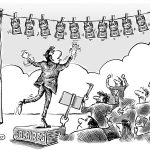The small rate that goes up…
Long-term interest rates are trending, is that really bad news?
Is Milton Friedman back, and with him inflation, a phenomenon everywhere and always monetary? The recent rise in long-term interest rates suggests this. Investors show some signs of nervousness, which the latest economic news from the United States (job creation and adoption by the Senate of the Biden mega- budget) should further stir up. Yet many doubt it. Would this time actually be different?
The latest US GDP growth forecast from the Atlanta Federal Reserve (GDPnow) is 8.3% in the first quarter. Even down from its previous estimate of 10%, it signals a clear acceleration in activity, which should continue in the following months thanks to the new injection of public funds into the economy, and the checks that will be distributed to households. The Federal Reserve for its part, far from changing its tone, has just unveiled a series of indicators for monitoring the labor market, focusing on taking into account not the average rate of activity in the total population, but that of the most vulnerable categories – ethnic minorities, long-term unemployed. With this work, the Central bank signals its attachment to a general restart of activity, which embraces the entire working population. Continuing the work started by Janet Yellen, now Secretary of State for the Treasury, the Fed therefore seems far from changing course. Under these conditions, the bond yield curve should continue to steepen.
Is the current upturn in inflation only temporary? Alternatively, will it take root more sustainably in the economy?
Should we be worried? Not necessarily. Unlike 2013, these increases clearly signal the rebound in economic activity, and not a imminent taper tantrum. The rebound should at least temporarily exceed its potential. In the short term, the rise in the so-called “risk-free” rate affects the prices of other assets. In this case, it could be a question of healthy normalization. The long-term trend hardly seems to be called into question: over the past 20 years, the rise in bond prices has gone hand in hand with that of the markets. The usual hierarchies also seem to be respected: the spread widens between European and American bond yields when the latter rise, while the slight fall in the euro is more likely to reassure the Continent, where the recovery is still lagging behind at the start of this year. There is a sense that investors will flock into the US debt (and the dollar), recycling their current account surplus.
Everything would therefore plead in favor of a dynamic recovery, which would admittedly be accompanied by further upward pressure on prices, these remaining limited and temporary1[1] and thus leaving full latitude to central banks to pursue their policies.
In support of this scenario, experts note that the acceleration of the money supply was accompanied by a further decline in its volocity. In question, a strong accumulation of savings largely forced by the circumstances (the confinements), but which could well freeze for a longer time under some “mattresses”. Some see it as the combined effects of an excessive prudential constraint weighing on the financial system, while the quantitative easing policies of the central banks would have only worsened the sterilization of the currency in the face of the growth of public debts. Added to this would be the effect of the internationalization of capital markets, the persistence of the “exorbitant privilege” of the dollar, and to a lesser extent of the euro, currencies which attract global savings to them, thus absorbing the growing debt of these economic zones.
The current increase would therefore only be the signal of a “return to reason” of the markets and valuations, the corollary of the general economic recovery, and therefore of the end of the pandemic, or even the beginning of a new growth phase, stimulated by public investment and the new global commercial situation.
However, there is room for doubt. Is the current upturn in inflation only temporary, or will it take root more sustainably in the economy? Fiscal tightening, even postponed, is already in the cards. Some emerging countries, such as Zambia, have defaulted or are on the verge of collapse.
The shadows of Milton Friedman, like that of Irving Fischer, still hang over our economies.
Original text in French published in Allnews.ch March 8th. ©Cartoon by Barret



